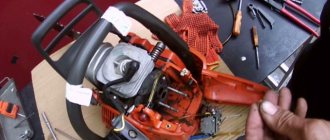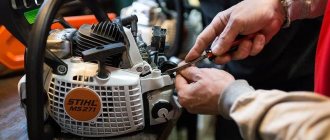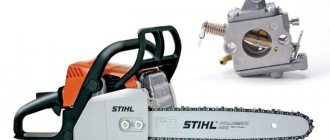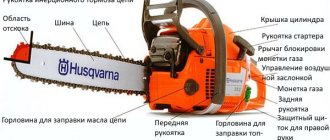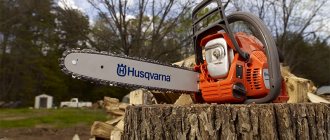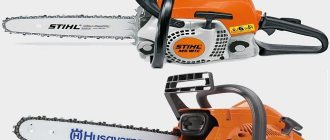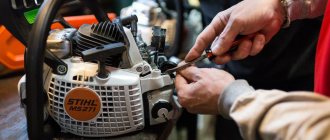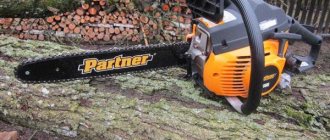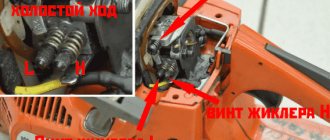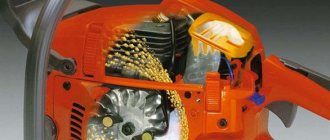Lean and rich mixtures
A little more about “poor” and “rich” mixtures.
"Rich Blend"
A “rich” mixture is a fuel mixture in which the amount of fuel supplied to the carburetor exceeds the norm. In this case, the fuel does not have time to burn completely and less energy is produced than with the optimal ratio of fuel and air. Partially unused fuel enters the muffler, which causes the chainsaw to smoke heavily.
"Lean mixture"
There is excess air in a “lean” mixture, which is also not good, as it has its drawbacks. Namely: insufficient energy during a flash (which means a loss of power as a result), excessive heating of the cylinder due to insufficient lubrication and high speeds, which leads to scuffing, and then it’s not far from “jamming” of the engine.
Work methodology
The Husqvarna carburetor is adjusted using screws L and H if gasoline is used that differs from that recommended by the supplier. If the octane number is low, to increase it, turn the screw using the unscrewing method. This will increase speed and power. But with an increased octane number, to lower it, you must turn the screw in the opposite direction, tightening it. This will help reduce engine speed.
When adjusting the Husqvarna carburetor, the screws must be used in the following order: L – H – T. By maintaining precise angles of rotation, you will follow the requirements that will allow you to maintain the best operating parameters of the engine. There is no universal way of adjustment. The procedures may differ from one another. But the process is usually divided into two stages. The first is basic, the 2nd is final. The basic stage is performed with the engine turned off, while the final stage involves warming up the engine for 10 minutes.
Read also: How to weld a pipe through light
How does a carburetor work on a Husqvarna 137 chainsaw?
Chainsaws of these models are most often equipped with a Walbro carburetor from the factory. Before adjusting the Walbro carburetor on a Husqvarna chainsaw, you need to have a minimal understanding of its structure and know the principle of operation.
What is responsible for supplying the mixture of fuel and oil
For precise supply of fuel and oil, the operation of a fuel pump is used, which is driven mechanically from the crankshaft. The carburetor itself is equipped with a diaphragm and a special needle valve, which are responsible for regulating the pressure in the system. Thanks to them, the correct operation of the dosing chambers and the pump is organized, which improves the operation of the chainsaw.
Preparing the fuel mixture
When operating a chainsaw, a fuel mixture of gasoline and oil should be used in a ratio of 15:1 by volume, i.e., 1 liter of oil should be added to 15 liters of gasoline and the mixture should be mixed thoroughly. The amount of gasoline and oil in the fuel mixture is given in this table:
| Petrol.l | 1 | 2 | 3 | 4 | 5 | 6 | 7 | 8 | 9 | 10 |
| Oil, l | 0.06 | 0.13 | 0.20 | 0,26 | 0,33 | 0.40 | 0.46 | 0.53 | 0.60 | 0,66 |
| Fuel mixture, l | 1.06 | 2,13 | 3,20 | 4,26 | 5,33 | 6.40 | 7.46 | 8.53 | 9.60 | 10.66 |
What is responsible for the air supply?
Two dampers installed on the diffuser chamber are responsible for the air supply. The first can regulate the amount of air at the moment you press the accelerator and is called the throttle, and the second ensures that the air supply is limited at the moment when the chainsaw is cold started. To make starting easier, the throttle is closed, which means the mixture becomes rich, as it is saturated with a large amount of fuel. It is easier to work in this mode, but since it increases fuel consumption, this mode is not used throughout the entire operation. The saw is working hard.
To spray fuel into the cylinders, an injector with a check valve is used.
The principle of operation is simple: it limits the return of the mixture back into the chamber. All the main malfunctions of chainsaws most often occur when this mechanism does not work properly.
- The most common mistake is storing the tool for too long. The fact is that with prolonged inactivity, the valve sticks and either fills the cylinder with fuel, or simply does not open.
- The second problem is an increase in the amount of air in the mixture, caused by its suction from the outside due to improper operation of the valve. It is no longer possible to adjust here, since in this case only repairing the valve or replacing it helps, since the saw will not respond to the adjusting screws.
Unlike a car, setting up a chainsaw carburetor provides three adjusting screws that are responsible for the quality of the mixture, quantity and nominal crankshaft speed of the Husqvarna engine:
- screw L – designed to adjust the number of revolutions when operating in medium modes and regulates low speeds;
- Screw H – adjusts the number of high speeds and thrust of the installation;
- T – is designed to adjust the total amount of fuel and adjusts the operation of the throttle assembly.
It is not recommended to touch the first two screws without special skills. The problem is that if you configure them incorrectly, the carburetor will not be able to start the engine, or even start it in the wrong operating modes. Such adjustment of the screw can lead to its rapid wear and failure. This principle is embedded in many devices.
No table provides the settings parameters. Therefore, you should not look for this data in specialized literature, but just strictly follow the instructions. The table in the passport has only informational value regarding the characteristics of the engine.
Chainsaw operating instructions
The Husqvarna 137 chainsaw, like other models of this brand, is equipped with an inertial automatic chain brake. This part was invented by engineers working at Husqvarna. Nowadays, most manufacturers still produce chainsaws with contact brakes. That is, the brake is activated when interacting with the hand during a reverse impact. In practice, such a contact brake may not work at all. Don’t forget to take care of your engine; to learn how to dilute gasoline with chainsaw oil, read this article.
The autovibration system of this model operates on the principle of “two masses”. The manufacturer does not produce other systems.
Husqvarna 137 is equipped with a high-profile professional chain (like a Stihl chainsaw). This is another difference from chainsaws with low profile chains. Chainsaws with high-profile chains have a forty percent higher chain. This is especially noticeable with large volumes of work. In addition, such chainsaws maintain high performance even when working with contaminated wood.
One of the most common mistakes when starting a Husqvarna 137 is closing the air damper without turning on the ignition.
It turns out that the fuel mixture enters the cylinder . But there is no spark, no ignition occurs. After this, you will have to unscrew the spark plug, wipe it and screw it back in. Therefore, it is worth remembering that all Husqvarna chainsaws have a combined damper, and the ignition in them will be turned on automatically at the moment when the damper lever is pulled out. There shouldn't be any errors.
Algorithm for checking the crankcase for leaks
- Remove the side cover and bar from the chainsaw.
- Unscrew the spark plug and insert a string with knots into the cylinder through the spark plug hole, thereby stopping the movement of the piston and crankshaft.
- You can use an old cord from a starter as a cord with knots, tying knots on it every 3-5 cm.
- Unscrew the chainsaw drive sprocket.
- Remove the oil pump cover and the pump itself.
- Remove the starter from the chainsaw.
- Unscrew and remove the flywheel.
- Remove the carburetor.
- Using a syringe, pour gasoline into the crankcase through the hole under the carburetor in the cylinder, while observing the crankshaft seals. If gasoline flows through them, it means the seals have become unusable and need to be replaced with new ones.
- It is better to entrust the installation of oil seals to professionals.
An indirect sign of crankcase leakage is oil leaks in the area of the seals.
Specifications
The parameters of the chainsaw compare favorably with those of similar light-class products.
Technical characteristics of the tool:
- type - gasoline, carburetor;
- engine power - 1.64 kW (2.2 hp);
- fuel tank volume - 0.41 l;
- oil tank volume - 0.20 l;
- engine volume - 36.3 cm³;
- number of links in the chain - 55;
- dimensions - 250x420x260 mm;
- noise level at full speed - 107 dB;
- weight without refueling - 4.9 kg;
- tire length - 40 cm;
Read also: How to make an ax handle for a cleaver
Included with the chain saw are spare spark plugs and branded oil for lubricating the chain.
How to install the repair kit?
If the problem affects the carburetor nozzle, you can try to fix the serious problem yourself. However, the manufacturer recommends dealing with this problem only by replacing the unit.
To remove the carburetor, you need to completely clear the saw of sawdust and shavings. To do this, you need to use a compressor and a compressed air gun. Next, unscrew the filter cap and remove the filter element. After this, all drives and throttle linkages are disconnected from the Husqvarna carburetor. Now you can remove the carburetor from the saw.
Next, you need to completely disassemble the carburetor and replace all the elements that the repair kit offers. Namely, spare parts and gaskets. This will save you from breakdowns in the future.
Now you know how to adjust the carburetor of the famous Husqvarna 137 chainsaw.
Carrying out the adjustment
The Husqvarna 142 carburetor must be adjusted using a tachometer. You must be able to work with it. If experience allows, manipulations can be carried out by ear, determining the maximum speed by sound. In other cases, a positive result may not be achieved. The Husqvarna 142 carburetor is adjusted with one, two or three screws. You can distinguish them by their designations.
Idle speed is adjusted with a screw under the letter T. You can adjust the minimum speed with screw L. While screw H is intended for maximum speed. You will see one idle screw and two others that will be hidden behind the cover. This version of the carburetor is explained by the fact that the manufacturer recommends that the operator adjust only one idle speed screw, since otherwise the optimal settings are already set at the factory. But for some extreme conditions you can make adjustments.
What to do if the chainsaw stalls at idle
- Probable reasons for failure
- Checking and repairing filters
- Checking the spark plug and ignition system
- Carburetor check and repair
- Muffler inspection and repair
- Conclusion on the topic
The chainsaw stalls at idle speed: many owners of this tool face this problem. In terms of its design, the saw is a fairly simple tool. But there are times when it fails. The main problem in troubleshooting is determining the correct cause of abnormal operation. Once the cause is identified, eliminating the defect is usually quite simple.
Circuit diagram of a chainsaw.
Probable reasons for failure
The power unit of all chainsaws is a single-cylinder internal combustion engine. Devices of this type are characterized by such malfunctions as violations of intra-cylinder compression, changes in the fuel mixture ratio, incorrect ignition operation, and low-quality fuels and lubricants. The main problems in the operation of the power unit are the following:
- The engine runs stably at minimum speed, but stalls when the speed increases
- startup occurs normally, but idle speed is unstable, stalls quickly
- won't start.
Electronic ignition circuit for a chainsaw.
Abnormal idle operation can be caused by various reasons. They can be divided into several positions:
- reduced filter capacity (gasoline and air)
- abnormal operation of the ignition system:
- carburetor settings changed spontaneously
- malfunction of fuel line elements
- clogged exhaust channels, muffler
- defects of the piston, cylinder, valves.
Repairs should begin with an external inspection and checking the presence of fuel in the tank.
Checking and repairing filters
The engine may run rough or stall if there is not enough fuel or air. Causes: clogged air or fuel filter. To check the fuel filter, you need to remove the fuel line hose from the carburetor fitting and direct it into a container. Then press the fuel pump several times. If the fuel is pumped normally, in clearly defined doses, without dirt, then the fuel filter is working properly. If the stream is weak or fuel is not pumped at all, the filter needs to be replaced or, if possible, cleaned.
Clogging of the fuel filter with sawdust is one of the reasons for chainsaw failure.
The device must be removed from the fuel tank (after draining all the fuel from it). On most models, the fuel filter can be pulled out with a wire hook through the neck. If the filter design is dismountable and can be cleaned, it must be disassembled and washed in accordance with the manufacturer’s recommendations. Otherwise, replace it with a new filter.
Similar problems can arise when the air filter is clogged with dust, sawdust, or dirt. If there is insufficient air, the fuel mixture will be enriched and the fuel combustion process will be difficult.
To check, remove the filter
During operation, precautions must be taken to prevent dust from entering the carburetor. The device must be cleaned and rinsed in warm water with added detergent.
After drying, if possible, blow with low-pressure compressed air and reinstall. If the chainsaw works normally, then the cause has been eliminated; if not, you need to look further.
If the tool is used continuously, it is recommended to replace the filters of the fuel and air systems after 3 months.
Checking the spark plug and ignition system
According to manufacturers' recommendations, the spark plug should be changed annually, regardless of the intensity of use of the tool. Failure to follow these tips leads to a completely natural result: failures at idle speed and subsequent failure.
Typical ignition system defects are as follows:
Moderator
pivovara said:
Recently, the chain in the chainsaw began to move at idle, and at first a little, but now quite quickly. At the same time, the gas lever was released. What could happen and how to treat it.
Quite calmly take the small screwdriver that was given to you along with the saw and turn it counterclockwise through the hole in the handle frame to the right. This must be done on a warm engine. And don’t turn it down too much – these engines like the idle higher.
Operating principle of the oil supply pump
Before removing the chainsaw pump, it is important to understand on what principle it functions.
The force generated on the drive is transferred to the plunger through a worm-type transmission (the force transmits rotational motion). The latter begins to spin, repeating a reciprocating type movement. The latter begins to spin, repeating a reciprocating type movement.
This type of movement is guaranteed due to the specific shape of the plunger, the adjusting screw, its thrust spring and the eccentric. When the plunger begins to move back, oil enters the reservoir through a small hole (we also see this principle in a regular syringe).
The forward movement forces the oil out through the same hole. It is easy to guess that according to this principle, the unit works only due to the tightness created by the rubber cuff. May not be indicated on the working diagram.
In addition, according to this principle, the pump only works if two holes are not open at the same moment. To prevent this from happening, the developers provided a segmented cutout at the tip of one plunger. While moving backwards, it turns towards the inlet. This hole closes when forward movement occurs. At the same time, the outlet hole is open, because the cutout is turned towards the last hole. One rotation of the plunger occurs with one reciprocating movement.
At the same time, manufacturers of saw main units can change the stroke of the plunger, which requires an eccentric and an adjusting screw. The first is visually just a cylinder integrated into the adjustment screw housing. The main axis of this part will not coincide with the axis of the adjustment screw even when the screw rotates.
The cylinder will move closer and further away in relation to the ribs of the plunger. This is necessary to know in order to understand the essence of the work and functions of the eccentric. This type of displacement of this part is the reason why it came to be called a “cam”.
If the plunger gets as close to the cam as possible, the oil will not be able to be pumped. Otherwise, the plunger will move the oil to maximum (pump at full power).
How does the plunger move?
Its movement is possible due to special processing of the end, which rests with a protrusion in the center against the eccentric. The edge of this end resembles a regular ring, surrounded by a protrusion located in the center. This ring is located at an angle, and not perpendicular to the axis of the plunger. Having formed a bevel, this part allows the plunger to protrude slightly.
In this case, the edge of the plunger and the adjustment screw are connected specifically. This makes it possible for the end to touch the screw during movement with different parts, protruding and not protruding. When the end touches the screw with the protruding part, the plunger rotates forward. And when the end touches the adjustment screw with the non-protruding part, a backward movement occurs. Reverse movement is possible thanks to a persistent spring.
Identifying Oil Pump Problems
If the operator knows how the booster pump works, he will be able to figure out how to remove the chainsaw pump. A minimum of plumbing skills and a minimum of tools are enough to do this and then repair the unit.
Please note that identifying the problem of the oil supply pump will allow you to understand what kind of component dismantling needs to be done, complete or partial. If you are afraid that you will not be able to cope with complete dismantling, contact a service workshop, where specialists will use their technical potential for this purpose. Of course, many parts that you can damage when dismantling a component can be replaced, but this replacement will cost you a pretty penny.
Please note that when the oil reservoir is full, but no oil is supplied to the saw set, the cause of this failure may not always relate to the oil pump. Sometimes, during the process of disassembling the saw, you will be able to detect a malfunction of other elements not related to this unit. Most often, replacing them solves the main problem.
In addition, before blaming the oil pump for all your troubles, check the oil filter, which, if heavily soiled, not only impairs the operation of the oil pump, but can also completely damage it. In order to check the oil filter, it is enough to hold a piece of paper over it, on which an oil streak will remain. The density of the latter will allow you to assess the condition of the filter and develop a plan for further action.
What to do if the chainsaw continues to not start?
If the initial inspection did not yield anything or the defects were eliminated during the search process, but the chainsaw still does not start, then you need to look for more serious reasons. It is best to identify and repair such breakdowns at a service center. However, if you have experience, you can find and eliminate them yourself. What to diagnose and check?
- Compression in the cylinder;
- Compression in the crankcase;
- Carburetor operation.
In the first case, checking the compression in the cylinder will allow you to find out the condition of the cylinder-piston group (CPG) of a chainsaw that does not want to start when cold. To do this you need a compression gauge. The device is screwed into place of the spark plug and the engine is started idle. Measuring the readings allows you to judge the condition of the CPG. In the absence of a compression gauge, you can determine the compression in the cylinder offhand as follows:
- Place your finger on the spark plug hole;
- Try to start the chainsaw engine.
By placing your finger on the spark plug hole and pulling the starter, you can check the compression in the cylinder
If you feel that your finger is being pulled strongly into the spark plug channel, then everything is in order with compression. The absence of vacuum in the chamber indicates a malfunction. The cylinder-piston group needs a more detailed inspection, which will give an idea of the condition of the piston and cylinder, piston rings and bearings.
A chainsaw may not start when cold due to a lack of compression in the engine crankcase. The main reason for this is damage to the gasket located between the cylinder and the crankcase. It is quite easy to detect a lack of compression:
- Disconnect the upper tube from the carburetor;
- Pour gasoline into a regular cork;
- We immerse the removed tube in the fuel;
- We pull the starter several times.
If fuel is sucked out of the cap when the chainsaw starter starts, then everything is fine with compression. If not, look at the gasket.
If the fuel is drawn in, then everything is fine - the gasket is intact. Otherwise, you will have to purchase a repair kit and make a replacement. How to do this, watch the video why a Chinese chainsaw won’t start:
Starting the tool may be complicated by improper operation of the carburetor or its breakdown. It often happens that during the sawing process the fastening screws become loose and air is sucked into the cylinder. Check that the carburetor is securely fastened. Inspect it for fuel leaks. There can be many reasons for the malfunction. It is possible to accurately determine the malfunction, eliminate it and fine-tune the carburetor only at a service center.
After going through a step-by-step troubleshooting of the chainsaw engine, you will be able to find the malfunction, fix it yourself and successfully start your working tool. Do not take on types of work that you are not confident in. Entrust troubleshooting and troubleshooting to specialists from the service center.
Every person who is familiar with gas-powered tools knows that sometimes the equipment works intermittently, or may stall at one point and not start again. There are many reasons why a chainsaw does not start; we will try to consider the most common of them.
Evaluation parameters and scope of application
The tool's high center of gravity, narrow configuration and flat body bottom contribute to the slow accumulation of fatigue. The user rating obtained during the survey is evidence of the high reliability, power and versatility of the model.
For a 10-point scale, the average was 8.3.
The characteristics of the tool determine its use in a wide range of household works, including:
- firewood preparation;
- preparation for installation of construction timber;
- formation of crowns of ornamental and fruit trees;
- independent production of wooden items for interior design and landscape design.
The saw successfully copes with single-pass, standard, longitudinal and diagonal sawing of hardwood with a diameter of up to 30 cm. The compact design makes it possible to work in hard-to-reach places, which is especially valued in construction technologies.
Why does a chainsaw stall when heating up?
The situation in which a chainsaw starts up when cold, but may stall while warming up, is familiar to many who deal with them. The main reasons for this behavior of the saw are as follows.
- The ignition module (coil) is faulty. You can determine the malfunction by checking the spark first on a cold engine, and then on a hot one. If there is no spark on a hot engine, then you should try to fix the problem by replacing the ignition coil.
- The chainsaw carburetor is not set correctly (fills the spark plug hot). You can determine the problem by how the saw starts when cold. If for a cold start it is not necessary to close the air damper, and the engine starts without a preliminary flash, then the fuel mixture is not formed correctly and after the engine warms up, the fuel floods the spark plug and makes starting impossible. The problem is eliminated by adjusting the carburetor.
- The spark plug is faulty. In such a situation, similar to a faulty ignition coil, the spark disappears when the engine heats up. It is worth trying to replace the spark plug with a new one, and if this does not help, then you need to check the ignition coil and the gap between it and the flywheel.
Engine malfunctions
- The engine will not start;
- starts but stalls;
- works unsteadily;
- does not develop power, i.e. It runs fine at idle, but stalls under load.
When repairing a chainsaw on your own, you need to use the method of elimination. Our client is left to check one by one the possible causes of the malfunction, starting with the development of those, the verification and elimination of which takes less time (see here about the device and operation of a two-stroke engine).
Ignition system
. Almost all types of engine problems listed above can be caused by ignition system failures. Therefore, when they occur, it makes sense to start troubleshooting with a spark plug. Chinese petrol mower. DIY repairs. Repairing an electric saw with your own hands, it is possible to repair electric saws and if the video is on. This is all the more justified since the state of the latter can provide useful information about the operation of the fuel system. So, if a problem occurs, you need to unscrew the spark plug and inspect it.
The wire is disconnected and the spark plug is unscrewed with a special wrench.
If the spark plug is dry, this means that the problem is most likely not in the ignition system, but in the fuel mixture not entering the cylinder. You can wrap the spark plug back and get to work on the fuel system. If the spark plug is heavily splashed with fuel mixture, it means there is an excess of it. This may occur due to carburetor misadjustment or violation of starting rules. The spark plug is wiped and dried, the cylinder is dried by turning off the fuel supply and operating the starter. to ventilate the combustion chamber and remove excess fuel. Then install the spark plug in place and repeat the start.
The presence of a large amount of black carbon also indicates a malfunction in the fuel system.
The ratio between oil and gasoline in the mixture may be incorrect, the carburetor may not be adjusted, or low-quality oil may be used. The spark plug is washed in gasoline, cleaned of carbon deposits with a needle or awl, the electrodes are cleaned with fine sandpaper and replaced.
In all these cases, it would be a good idea to check the gap between the spark plug electrodes. Depending on its brand, it should be in the range of 0.5-0.65 mm. You also need to check the spark plug seal. If it is worn out or damaged, the tightness of the combustion chamber may not be ensured, which leads to a decrease in compression in the cylinder and problems in engine operation.
Even if, when checking the spark plug, there is good reason to believe that the fault is in the fuel system, you need to check the spark plug for the presence of a spark. At least to be sure that everything is in order. Do-it-yourself chainsaw repair Shtil 180 video. For this:
- put the ignition cable on the spark plug;
- using pliers with insulated handles, apply the thread or nut of the spark plug to the cylinder;
- pull the starter handle and watch. whether there is a spark or not.
Read:
If there is no spark, you just need to replace the spark plug. If the new spark plug does not have a spark, you need to check the condition of the high-voltage wire for a break and contact with the spark plug.
The reason for the lack of a spark may also be a faulty ignition module or a violation of the gap between it and the flywheel magnetic circuit. It should be 0.2 mm. Violation of the gap becomes especially likely if the saw was previously disassembled and the flywheel and ignition module were removed. The gap is set using a 0.2 mm thick gasket placed between the flywheel boss and the ignition module. A faulty ignition module must be replaced.
Having checked the ignition system in this way and not finding a malfunction, you can move on to the fuel mixture supply system.
Fuel supply system
. If by inspection of the spark plug it is determined that fuel is not entering the cylinder, all possible reasons for this need to be considered. It could be:
- failure of fuel to flow from the tank due to a clogged hole in its lid (breather), while a vacuum is created in the tank, preventing fuel from leaking out;
- contamination of the fuel filter installed in the tank;
- no or insufficient supply of fuel mixture from the carburetor to the cylinder.
To diagnose the first two reasons, it is enough to disconnect the fuel hose from the carburetor and see whether fuel flows out of it or not. If it flows in full stream, the breather and filter do not need to be checked; if it does not flow or flows weakly, we can assume that the cause of the malfunction has been found. The breather is cleaned with a needle. The fuel filter is removed through the filler hole of the empty fuel tank using a wire hook, along with a suction hose, from which the filter is disconnected and cleaned or replaced with a new one. Chainsaw manufacturers recommend changing the fuel filter every three months.
Chainsaws "Husqvarna" - main malfunctions
A tool from a Swedish manufacturer can turn hard work into a simple task. The Husqvarna 137, Husqvarna 240 and Husqvarna 365 chainsaw models are distinguished by three features:
- high engine power;
- improved engine filtration system;
- the ability to absorb excess vibrations.
If you operate the tool strictly according to the instructions and correct its problems in a timely manner, then it will delight you with reliable and stable operation. Correctly carried out repairs with original spare parts will allow you to use the saw for a long time.
The main cause of chainsaw failure is most often engine failure, which can manifest itself as follows:
- won't start;
- Unstable operation at idle speed;
- starts and stalls immediately;
- do not have enough power.
In this case, the fault should be looked for in the ignition system, piston group or fuel system. Often the reason for poor tool performance may be related to the clutch, brake system, lubrication mechanisms, or tire.
Ignition system
Do-it-yourself repair of the Husqvarna 240 chainsaw, or any other model, should begin with troubleshooting in the ignition system.
First of all, experts recommend removing and inspecting the candle. The condition of this element will indicate shortcomings in the operation of the fuel system.
- If the spark plug is completely dry, it means that the fuel mixture is not entering the cylinder. In this case, the spark plug is screwed into place and the fuel system is repaired.
- If the spark plug is heavily flooded with the fuel mixture, the rules for starting the unit may be violated, or the carburetor may be poorly adjusted. It is necessary to turn off the fuel supply and start the starter. This is done in order to remove excess fuel. The candle must first be cleaned with a sharp object, then washed with detergents, dried with a hairdryer and put back in place. After this, the tool is launched and its operation is checked.
- If there are no fuel residues on the spark plug, then it must be cleaned, washed and checked for the presence of a spark. Its absence may indicate a violation of the gap between the flywheel and its magnetic circuit or a breakdown of the ignition module.
A malfunction in the ignition system may be due to the use of bad oil or an incorrect ratio of gasoline to oil.
Fuel supply system
If fuel does not enter the chainsaw tank, there may be two reasons for this:
- The filter is clogged.
- The lid is clogged.
In this case, the fuel is not supplied in full, and the tool does not start or starts and immediately stalls. The repair consists of cleaning the air filter and cover.
The filter must be removed very carefully so that the dirt that clogs it does not get into the carburetor. It can be cleaned and washed with ordinary detergents.
Carburetor repair
The heart of any chainsaw is the carburetor, which is responsible for most tool failures.
Do-it-yourself repair of this unit involves disassembling and cleaning. If the breakdown is serious, then you should contact a service center for help.
Most often, tool malfunctions are associated with the use of low quality gasoline or oil. To protect the carburetor from damage, you must follow some preventive measures:
- The chainsaw should be started strictly according to the instructions.
- It is not recommended to store gasoline in a plastic container. This will help avoid severe soot.
- The fuel mixture cannot be stored for a long time, as over time it loses its quality.
Checking and adjusting the carburetor
In service centers, carburetor adjustment is carried out using special equipment. For each saw, the angles of rotation of the adjusting screws are different (they are indicated in the operating instructions). The need to adjust the carburetor does not arise very often, especially if the saw was purchased from a trusted seller. All of our Husqvarna saws are sent to a service center before being sold, where specialists adjust the speed control.
However, failure to secure the adjusting screws sometimes occurs.
Reasons for failure to adjust the chainsaw carburetor:
- Severe wear on the engine (pistons). In this case, it is necessary to take greater care of repairing the engine, but adjusting the carburetor can improve the functionality of the saw for a certain amount of time.
- Blockage in the carburetor due to damage to the air filter, use of poor quality gasoline and the formation of scale. In such a situation, in addition to adjusting the carburetor, you will also need to flush it.
- Severe vibration of the saw or damage to the protective cover. This happens extremely rarely, but there are still cases.
Signs that indicate the need to adjust the chainsaw carburetor:
- The engine either does not start, or starts and immediately stalls. This occurs due to the use of a poor fuel mixture.
- Significant increase in fuel consumption and emissions. An increase in the amount of exhaust gases indicates that the fuel is not completely burned. The reason for this may be fuel oversaturation.
The carburetor adjustment scheme differs for different models of chainsaws and is described in the operating instructions. However, the general principle remains the same: it is necessary to change the quantity and quality of the fuel mixture supplied to the engine cylinder.
Three screws will help us adjust the carburetor:
- “L” – low, for setting low speeds
- “H” – high, for setting the upper speed
- “T” (“LA”, “S”) – for adjusting the idle speed (models that have only one screw have the “T” screw)
When adjusting the carburetor of a chainsaw, the following rules should be observed:
- Make sure the saw chain is pointing away from you
- Place the saw on a stable, level surface; the cutting part should not touch any objects.
Please note: the instructions indicate the exact angles of rotation of the adjusting screws. Strict adherence to the instructions in the instructions will avoid damage to the engine.
The process of adjusting the carburetor itself includes two points: basic (with the engine not running) and final (with the engine warm and turned on).
Design and features of Husqvarna 236
The structure diagram of a chainsaw is shown in the picture below:
The design of the Husqvarna 236 chainsaw ensures operator comfort and safety. An emergency brake is provided to quickly stop the mechanism. There is also a system for catching a chain that has fallen off, which protects against accidental injuries during work. The air purification system is centrifugal and promotes efficient cooling. Vibration protection reduces the load on the operator and allows you to work for a long time without interruption. The fuel system is equipped taking into account environmental standards and additionally cleans exhaust gases from harmful compounds. Reducing fuel consumption was achieved using the Husqvarna 236 X-torq chainsaw equipment - an innovative system that reduces fuel consumption by 20%.
How to start a chainsaw correctly - common methods
Each time, by correctly starting the engine of a utility gasoline saw, its owner ensures the coordinated and smooth operation of the garden tool’s devices, and also prevents rapid wear of its consumable parts. The procedure for starting a cool engine of different models may differ slightly, but almost always it looks like this:
- The first step that the operator must take is to set the lever that regulates the position of the integrated throttle valve to its lowest position. With all this, you need to take into account that the lever can only be switched to this mode if the gas trigger is pressed. By moving the lever down, the operator will close the damper located in the standard carburetor and lock the gas supply lever in the clamped position;
- Next you need to start manipulating the starter cable. To do this, you need to insert your right leg into the “eye” located in the back of the body, and rest your left hand on the handle of the chainsaw. Then you need to sharply pull the cable of the built-in starter of the garden tool a couple of times. As the saw engine starts and stalls, the throttle position switch lever will need to be moved up one position;
- After which you will need to sharply pull the recoil starter cable a couple of times again. As a result, the internal combustion engine of the saw should start and immediately begin working at the highest possible speed. This is due to the fact that the operator previously fixed the throttle trigger in a clamped position;
- Then you need to press the standard gas trigger once and immediately release it. After which the throttle valve shift lever should return to its operating position. This will immediately reduce the engine speed. This means that you can start using the chainsaw on the site.
If the operator needs to start a garden tool with a warm engine, then to do this, the throttle position lever must be moved to the penultimate position up and the starter rope must be pulled. To turn off the engine, the throttle position switch lever will need to be moved to a very acceptable upper position.
READ Chainsaw Works But Chain Doesn't Spin
In some models of chainsaws used in households, the industrial motor is started in the following sequence:
- First you need to turn on the ignition and move the switch to the appropriate operating position;
- Next, you need to press 5-6 times on the transparent plastic primer required to pump fuel into the cylinder;
- The operator will then need to fully pull out the integrated throttle valve position adjustment lever;
- Then you need to sharply pull the recoil starter cable a couple of times. Once the factory engine starts and stalls, you will need to press the throttle adjustment lever all the way in and pull the starter lever a couple more times. The operating instructions for some models indicate that after the engine stalls, the damper adjustment lever must be pressed only halfway. With all this, it is necessary to fully press the lever only after the chainsaw’s internal combustion engine has started and begins to operate smoothly;
- In models where the throttle trigger is fixed when the throttle adjustment lever is pulled, the engine will start to operate at high speeds. If the gas trigger in the chainsaw is not fixed, then the engine speed will be the lowest. Because of this, the internal combustion engine may stall a few seconds after starting. In this case, it is necessary to start the engine of the garden tool until it warms up and begins to work more steadily.
If the operator needs to start a chainsaw with a warm engine, then he will only need to turn on the ignition and sharply pull the starter cable a couple of times.
Consumer Reviews
You can adjust the Husqvarna 142 chainsaw yourself. Consumers consider this feature a plus, as well as the fact that the crankshaft in the design is made of forged steel. Another advantage is the relatively easy access to the air filter. The ignition system is durable and simple. The piston group has two compressor rings, which have an increased working life. The manufacturer emphasizes that they will be ready to last up to 5 years.
Consumers also like the fact that the cylinder liners have a wear-resistant chrome coating. You may not have to adjust the Husqvarna carburetor, because, according to the manufacturer, it is the best in its class. The design is also good because it has a built-in primer. It is a pump that provides the engine with a quick start. This feature is independent of ambient temperature.
